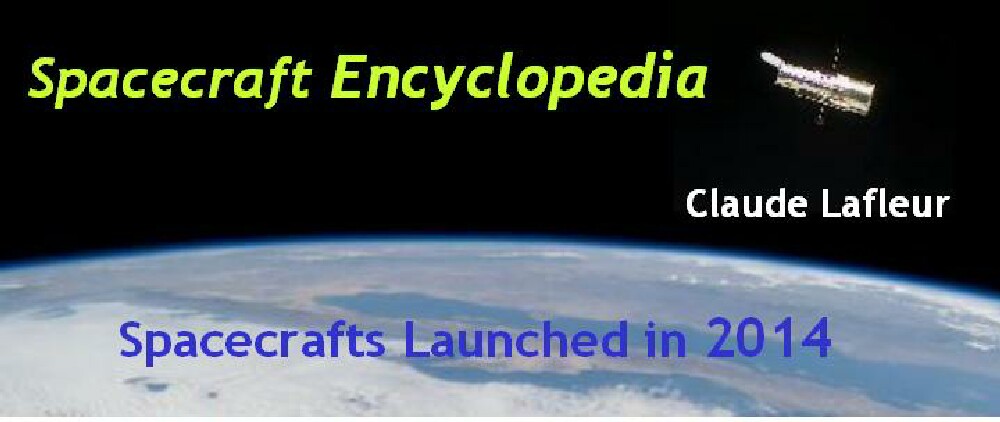Angara 1.2PP
| Spacecraft: |
PP means Pervy Polyot, first
flight. |
| Chronologies: |
2014 payload n/a (suborbital test flight) |
| Type: |
Technology (new launcher test) |
| Families: |
|
| Ranks: |
|
| Sponsor: |
Russia |
|
|
| Launch: |
9 July 2014 at 12h08 UT, from
Plesetsk Cosmodrome, by an Angara. |
| Orbit: |
n/a |
| Mission: |
Angara 1.1PP (“Pervy Polyot“, first flight)
is the mainden flight of the new Russian modular rocket designed to become
the workhorse of Russia's space program by replacing most of the Russian
launchers (see Note below). The Angara rocket lifted off on 9 July 2014
at 4:08 Moscow time, and flew for 25 minutes on a sub-orbital ballistic
trajectory before landing at the Kura test-range in the far eastern Kamchatka
Peninsula, 5,700 kilometers away from its launch site.
The first stage
of the Angara-1.2PP is a single “Universal Rocket Module”, URM-1, with
an RD-191 engine, and the second stage, URM-2, using an RD-0124A engine.
The demonstration flight carries an instrumentation payload to measure
various technical parameters during the suborbital mission. Angara 1.1PP
was launch from the new launch facility at Plesetsk’s site 35, a launch
pad originally designed for the Zenit rocket but modified to host the Angara
launcher.
Initially, Angara
1.1PP was scheduled to lift off on 27 June 2014, but the counteown was
automatically stopped in the final minutes. Three days later, the rocket
was removed from the launch pad for additional checks. On 5 July, it was
reported that this first attempt was cancelled due to a faulty valve of
the liquid oxygen tank: “The valve’s malfunctioning was a result of sloppy
assembly.” |
| Notes: |
According to Russian sources, a big advantage
of the new Angara launcher is its “universal space rocket system” capable
of taking three types of carrier rockets launched from the same launch
pad: light, with a payload of up to 3.5 tonnes, medium, with a payload
of up to 14.6 tonnes, and heavy, with a payload of up to 24.5 tonnes. The
vehicle uses a unique design since it can be assembled of one or more “Universal
Rocket Module,” (URM). The number of URM is five in a heavy version, three
in a medium version, and one in a light version.
The rockets are
based on modules powered by the RD-191 engine using kerosene and liquid
oxygen. One such module makes up the first stage of the light class Angara
1.1 and Angara 1.2 boosters. (Their second stages are different.) The medium
and heavy class boosters Angara-3 and Angara 4 are an extension of the
light class types with additional three or four universal modules. The
booster can be equipped with the Briz-M or KVRB accelerator upper stage.
The Angara 1 light
class of small launchers is intended to replace the Kosmos-3M, Tsyklon
and Rokot launchers. The Angara 3, a medium-lift launcher, is meant to
eventually replace the Zenit and Angara 5 is meant to replace the heavy-lift
Proton. A future super heavy-lift Angara 7 is also planned if needed.
The Angara project
started in 1993 with the goal to develop a new national space launch system.
The family of these rockets has been under development since 1994. |
| History: |
ITAR-TASS news agency reports: “Angara is
the first civilian rocket developed by Russia since the death of Soviet
space rocket designer Sergei Korolyov in 1966.
After the USSR’s
disintegration in 1991, Russia felt an urgent need to create a heavy-class
carrier rocket. In 1992, three Russian companies, including RSC Energia,
the Khrunichev Space Center and the Makeyev Rocket Design Bureau, took
part in the designing of a heavy space rocket complex. In 1994, the Khrunichev
won the contract. A year later, in 1995, the Russian government passed
a resolution setting the deadline for starting the Angara flight tests:
2005.
The prototype of
Angara’s first stage (URM-1) was successfully flight tested as part of
the first South Korean KSLV-1 carrier rocket in
2009, 2010 and 2013.
More than 100 billion
rubles (approx. $2.9 billion) have been invested in the Angara project
over the past 20 years. |
| Source: |
Jonathan
Space Report No. 699
; Spaceflight Now's Stories
; ITAR-TASS
21 Dec 13,
31
Jan 14,
7 Feb 14,
17
Feb 14, 19 Feb 14,
17
Mar 14, 18 Apr
14, 5 May 14, 4
Jun 14, 20 Jun
14, 26 Jun 14,
27
Jun 14, 27 Jun
14, 14 Jul 14,
15
Jul 14 ; SpaceRef's 23
Jun 14, 30 Jun
14, 2 Jul 14,
5
Jul 14, 9 Jul
14, 9 Jul 14
; MT's 9 Jul 14 ; |
|
|



